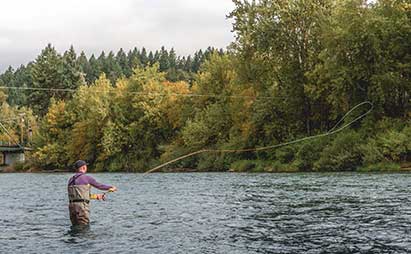Practitioners of the two-handed cast hit the Snake River
By Mike Commins
There are no steelhead in Jackson Hole. There are, however, a number of local trout fishermen who travel long distances from Jackson Hole for the opportunity to fly fish for steelhead or Atlantic salmon. Many of those fishermen have learned to cast the long, two-handed fly rods commonly called Spey rods. Not surprisingly, the rods got their name from the River Spey, in Scotland, where they were invented.
Renowned local fisherman Howard Cole saw his first 15-foot Spey rod while fly fishing for steelhead in British Columbia in the early 1990s. He had been casting heavy 7 or 8 weight single-handed rods at the time, and the long, effortless casts the Spey guys were making, as well as their ability to make those casts without needing a back cast (an advantage when fishing in front of steep banks and obstacles) got his attention.
Wasting little time, Howard got his first two-handed rod, but soon discovered that Spey casting was not nearly as easy as it looked. At the time there was no YouTube to provide instructional videos, but fortunately for Howard, the Snake River in Jackson Hole was nearby and he and a small group of locals began to figure out things on their own.
Two primary methods of Spey casting (traditional and Scandinavian) were in practice at the time Howard and his friends were getting started. At the same time, a third variation was being invented by a group of fly fishermen who regularly fished for winter steelhead in the Skagit River in Washington State. The Skagit cast, as it came to be known, had the advantage of using a heavier and shorter head section to the line, allowing for a more compact casting stroke and helping a big fly sink fast in the high water of a Pacific Northwest winter. Howard joined the other early practitioners of the Skagit cast who were creating their own fly lines, by cutting lengths of different weights of line and welding them together to find that perfect combination of rod and line. It would be another 10 years before Rio, the Idaho Falls, Idaho, fly line company marketed its first Skagit line.
As the sport continued to evolve, smaller two-handed “switch” rods became available for trout enthusiasts who want the benefit of two-handed casting, but with a less stout rod that is suitable for trout. Switch rods are particularly effective at casting larger trout streamers and wet flies, and provide the additional benefit of keeping your Spey skills in shape for salmon and steelhead seasons.
Those looking to get into Spey casting should know that the informal casting sessions with Howard and his friends are open to all on Wednesday evenings, beginning around July 4 and continuing until early September near the Snake River Bridge. These sessions are the ideal opportunity for a novice caster to benefit from the years of trial and error of local anglers.
The Snake River sessions have evolved into the scheduling of a once-a-year event with demo rods, reels, and lines, as well as casting demonstrations. Events like this have been dubbed “Spey claves” in the vernacular of two-handed fishermen, who appear to be more than willing to welcome new members to the Spey casting club. In late June, 2016, Howard hopes to bring the local Spey clave to a new level with a visit from the world two-handed distance casting champion, Travis Johnson. For dates and times of the event, as well as information on the Wednesday evening sessions contact Howard Cole at JD High Country Outfitters (307) 733 3270.

